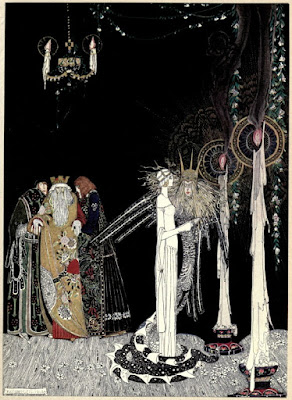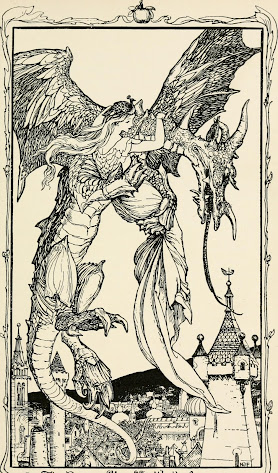My interest in RPGs and D&D, in particular, came from my love of Greek myths. I was already a fan of Greek myths when I first picked up a copy of the AD&D Monster Manual all the way back in 1979. So I could not in good conscious even think about bringing a new monster book to life if it did not somehow honor both my love for those old myths and that original book. So to that end, here is the Faun, a creature from Greek/Roman myths and related to the satyr of those myths and the Monster Manual.
Faun
Medium Fey
| Faun | Greater Faun | |
| Frequency: | Very Rare | Very Rare |
| Number Appearing: | 1d4 (1d8) | 1d2 (1d6) |
| Alignment: | Neutral (Chaotic Good) | Neutral (Chaotic Neutral) |
| Movement: | 120' (40') [12"] | 180' (60') [18"] |
| Armor Class: | 6 [13] | 4 [15] |
| Hit Dice: | 1d8+1* (6 hp) |
4d8+4* (22 hp) |
| THAC0: | 18 (+1) | 15 (+4) |
| Attacks: | 1 weapon, song | 1 weapon, song |
| Damage: | 1d6 | 1d6+1 |
| Special: | Song, fey qualities | Song, fey qualities |
| Save: | Elf 1 | Elf 4 |
| Morale: | 8 (8) | 8 (10) |
| Treasure Hoard Class: | XVI (G) | XVI (G) |
| XP: | 15 (OSE), 15 (LL) | 200 (OSE), 215 (LL) |
Fauns are fae people of the forest who love to entertain guests and go on dangerous quests. They can be rash and temperamental, and sometimes are reckless with the powers of their music. They are friendlier to men than most faeries, though are quickly angered by the destruction of woodland. Fauns, like satyrs, are the male counterparts to nymphs and dryads. When not playing music or drinking they are usually found chasing after nymphs. The offspring of a faun and nymph is a satyr if male and a nymph if female. As a creature of the fey, the faun is vulnerable to iron. They take double damage from any weapon made from cold iron. Additionally, they are immune to the effects of charm, sleep or hold spells unless they are cast by another fey creature of greater level/HD.
Fauns are the wilder cousins of the satyr. Like satyrs, they are rarely surprised (1 on a 1d8). Fauns all play musical instruments like pan pipes, flutes, or drums. If a faun plays everyone that hears must make a save vs. Spells or be affected by an Irresistible Dance spell. If the faun is with a mixed group of satyrs then their song of charm, fear, or sleep can also be in effect, with separate saves.
A faun will engage in combat to protect their lands, their fellow fauns, and nymphs or their herds of goats. Typically a faun is very much the stereotype of a lover and not a fighter. They can be bribed with wine, the stronger the better.
A faun appears to be much like a satyr. They are medium-sized with human-like broad hairy chests and muscular arms. Their lower half is that of a goat. Their faces are a combination of elf and goat with elongated faces, goat-like years and horns, and a beard.
Greater Faun: Greater Fauns are the larger and wilder varieties of fauns and satyrs. They are stronger and tougher than normal fauns and will act as leaders. Greater Fauns will claim descent from some god, typically Pan or some other primal nature diety.
Each greater faun has a True Name. Anyone that knows the True Name of a greater faun has power over him as per the spell Suggestion.
Some greater fauns are shamans and can also cast spells as a 2nd level druid.
--
So a tabled monster block today with two varieties. These are proper fae creatures so they have the vulnerability to iron.
Doing this table has pointed out some deficiencies in my approach though.
For starters, my Treasure Type/Horde Class needs some work. While XVI (G) makes sense to anyone that plays Labyrinth Lord and/or OSE, it is fairly inelegant. One, XVI or G would suffice. I guess I could just put the treasure types in the back of the book and work it out that way.
Secondly, and this is related to the same larger issue, my XP values are also a bit of an eyesore. Yes I am happy with the numbers I am getting. But while OSE and LL are covered this does nothing for the GM using say Swords &Wizardry or AD&D. I could just leave it blank, but XP listings are one of the really great things about later books and editions of the game.
Likely there will be a table in the back of the book with all the monsters listed with their XP values for various systems. That makes the most sense. But likely I will leave at least one there.










